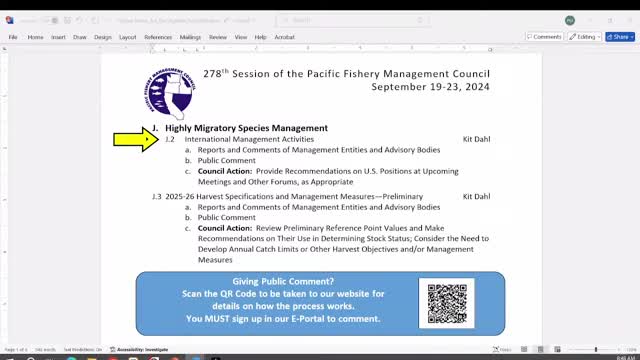Major catch limit increases spark debate on fishery management
September 23, 2024 | Fishery Management Council, Pacific, Governor's Office - Boards & Commissions, Executive, Washington
This article was created by AI summarizing key points discussed. AI makes mistakes, so for full details and context, please refer to the video of the full meeting. Please report any errors so we can fix them. Report an error »

In a recent government meeting, significant discussions centered around the management of Pacific Bluefin tuna stocks, highlighting substantial increases in catch limits based on a benchmark stock assessment. The assessment, adopted by the International Scientific Committee (ISC) earlier this summer, revealed that the estimated spawning stock biomass is currently at 23.2% of unfished levels, surpassing the second rebuilding target of 20%.
The ISC was tasked with providing projections on various catch limit scenarios and their potential impacts on stock status and rebuilding efforts. The negotiations that followed resulted in notable increases in catch limits, particularly for large fish, which saw a 56% overall increase. In contrast, the increase for small fish—those weighing less than 30 kilograms—was capped at 8%, reflecting a strong push from the U.S. to maintain stricter controls on smaller catches, which have been linked to high mortality rates among younger fish in Japanese waters.
The meeting also addressed the implications of these new catch limits for the Eastern Pacific Ocean (EPO), where the U.S. and Mexico are expected to see nearly a 60% increase in their quotas. This substantial rise will necessitate revisions to domestic management measures for Bluefin tuna, a topic slated for further discussion in the meeting.
Additionally, the meeting touched on the North Pacific Albacore Harvest Strategy, noting that no progress was made this year by the Northern Committee. Stakeholders expressed hope that next year would bring advancements in establishing management controls for this important fishery.
Overall, the meeting underscored the ongoing efforts to balance fishery management with conservation goals, as stakeholders navigate the complexities of increasing catch limits while ensuring the sustainability of Pacific Bluefin tuna populations.
The ISC was tasked with providing projections on various catch limit scenarios and their potential impacts on stock status and rebuilding efforts. The negotiations that followed resulted in notable increases in catch limits, particularly for large fish, which saw a 56% overall increase. In contrast, the increase for small fish—those weighing less than 30 kilograms—was capped at 8%, reflecting a strong push from the U.S. to maintain stricter controls on smaller catches, which have been linked to high mortality rates among younger fish in Japanese waters.
The meeting also addressed the implications of these new catch limits for the Eastern Pacific Ocean (EPO), where the U.S. and Mexico are expected to see nearly a 60% increase in their quotas. This substantial rise will necessitate revisions to domestic management measures for Bluefin tuna, a topic slated for further discussion in the meeting.
Additionally, the meeting touched on the North Pacific Albacore Harvest Strategy, noting that no progress was made this year by the Northern Committee. Stakeholders expressed hope that next year would bring advancements in establishing management controls for this important fishery.
Overall, the meeting underscored the ongoing efforts to balance fishery management with conservation goals, as stakeholders navigate the complexities of increasing catch limits while ensuring the sustainability of Pacific Bluefin tuna populations.
View full meeting
This article is based on a recent meeting—watch the full video and explore the complete transcript for deeper insights into the discussion.
View full meeting
